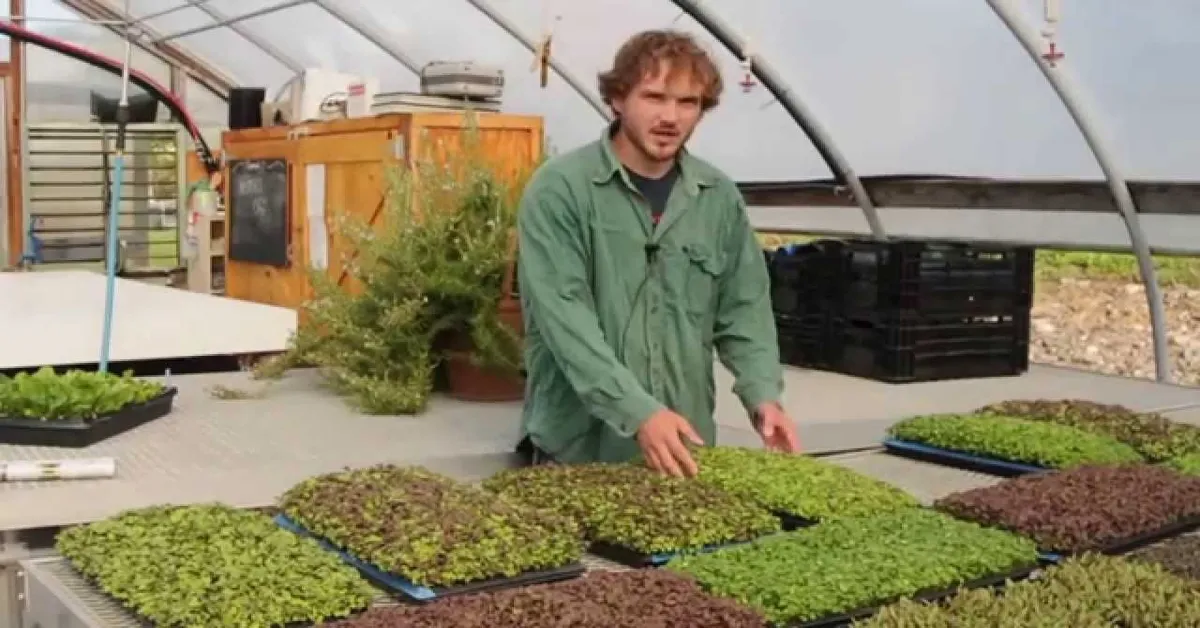Key Takeaway
Urban microgreens are tiny plants packed with nutrients. They grow in cities where there’s not much space. This is a smart way to get fresh veggies.
Here’s why they’re great:
- They don’t need much room. You can grow them inside or in small outdoor areas.
- These little plants are full of good stuff for your body.
They can have more vitamins and minerals than full-grown veggies.
- They are easy to grow. Even if you don’t have a green thumb, you can grow microgreens.
They grow fast, too!
- They help the planet. Growing food in cities can cut down on how far food has to travel. This means less pollution from trucks.
- You can grow them all year. No need to wait for the right season. This means fresh greens anytime!
They’re good for you, easy to grow, and help the earth. It’s a win-win for everyone!
**Introduction to Urban Microgreens**
In the heart of the city, a green revolution is taking place. It’s all about **urban microgreens**. These tiny plants are not just cute; they’re packed with nutrients.
Let’s dive into the world of urban microgreens and find out why they’re becoming so popular. First off, what are microgreens? They’re young plants, just a few inches tall. People grow them from seeds.
They include veggies and herbs. Think of baby spinach or tiny basil. But there’s more to these little plants than meets the eye.
Growing microgreens is easy and fun. You don’t need a big garden. All you need is a small space, like a windowsill or a balcony.
Even a tiny corner in your kitchen will do. You plant the seeds in a tray, give them some water, and wait. In no time, you’ll see them sprout and grow.
Why are microgreens so great? Well, they’re super healthy. They have more vitamins and minerals than mature plants. Eating them can give your body a big boost.
urban micro greens
| Type | Benefits | Growing Conditions |
|---|---|---|
| Arugula Microgreens | Rich in vitamins A, C, and K, enhances bone health and immune system. | Requires 4-6 hours of sunlight, moist soil, and 40-60°F temperature range. |
| Broccoli Microgreens | Contains sulforaphane, promoting heart health and reducing the risk of cancer. | Thrives in slightly acidic to neutral soil, needs consistent moisture and light. |
| Radish Microgreens | Offers high levels of Vitamin E, antioxidants, and boosts metabolic rate effectively. | Prefers full sun to partial shade, well-drained soil, and 55-75°F temperature. |
| Pea Microgreens | High in fiber and protein, supports digestion and helps in weight management. | Grows best in cooler temperatures, requires ample water, and partial to full sun. |
| Sunflower Microgreens | Rich in healthy fats, essential for brain health and lowering cholesterol levels. | Needs 6-8 hours of direct sunlight daily, well-draining soil, and regular watering. |
| Wheatgrass | Boosts immunity, detoxifies the body, and provides a high chlorophyll content. | Can be grown indoors, requires indirect light, and needs to be kept moist. |

**Benefits of Growing Microgreens**
Urban microgreens are tiny but mighty. These little plants are grown in cities, where space is often limited. They don’t need much room to grow.
A small corner on your kitchen counter or a tiny balcony can be enough. This makes them perfect for city dwellers craving a touch of green and freshness in their lives. Why are urban microgreens gaining popularity? Well, they are not only easy to grow but also pack a punch of nutrition.
These little greens are full of vitamins and minerals. They can make your meals both healthier and tastier. Plus, growing your own greens can be a fun and rewarding hobby.
It connects you with nature, even in the middle of a bustling city. Another great thing about urban microgreens is their speed. They grow quickly! Some types are ready to eat in just a week.
This means you can enjoy fresh greens almost anytime. It’s like having a mini garden that produces a constant supply of fresh leaves for your salads, sandwiches, and more. So, how do you start growing these greens? It’s simple.
You only need a few basic items: seeds, a container, soil, and water. You don’t need special gardening skills. Just sprinkle the seeds in the soil, keep it moist, and watch your microgreens grow.
**Getting Started with Your Microgreen Garden**
Discovering the Magic of Urban Microgreens In the heart of the city, where skyscrapers touch the sky and the hustle never seems to end, a green revolution is quietly taking root. Urban microgreens, tiny but mighty, are transforming balconies, windowsills, and rooftops into lush, edible gardens. These little greens are not only a feast for the eyes but also a powerhouse of nutrition.
What Are Urban Microgreens? Microgreens are young vegetable greens. They are harvested just after the first leaves have developed. Despite their small size, they pack a flavor and nutritional punch.
They can be grown from almost any vegetable or herb seed, including kale, radish, beet, basil, and more. Urban microgreens bring the farm to the city. They thrive in small spaces.
You don’t need a backyard to grow them. A small tray on a windowsill is enough. This makes them perfect for city dwellers craving a touch of greenery and freshness in their meals.
The Nutritional Powerhouse Beyond their vibrant colors and fresh flavors, microgreens are nutritional powerhouses. They contain higher levels of vitamins and antioxidants compared to mature vegetables. Including them in your diet can boost your health.
You get a lot of goodness in just a small handful of greens. Easy to Grow and Harvest One of the best things about urban microgreens is their simplicity. You don’t need green fingers to grow them.
**Caring for Your Urban Microgreens**
Urban microgreens: The Tiny Powerhouses of Nutrition **Urban microgreens** are not just any ordinary greens. They’re like the superheroes of the plant world, packed in a tiny package. Imagine this: a small plant bursting with flavor and nutrients, so powerful that it can turn any meal from meh to magnificent.
That’s the magic of urban microgreens. **Why Microgreens?** First off, let’s talk about why microgreens are making such a big splash in kitchens and restaurants around the world. These little plants are harvested just after the first leaves have developed.
Despite their small size, they’re mighty in nutrition. Studies have shown that microgreens can contain up to nine times the nutrients of their mature counterparts. Yes, you heard that right – nine times! But it’s not just about nutrition.
In cities where space is a premium, urban microgreens offer a practical solution for growing your own food. You don’t need a garden or even a balcony. A sunny windowsill or a small indoor planter is all it takes to start your own microgreen garden.
**Growing Your Own Microgreens** Now, you might be thinking, “That sounds great, but I don’t have a green thumb.” Fear not! Growing microgreens is as easy as 1-2- You simply sow the seeds in a shallow tray of soil or a hydroponic setup, keep them watered, and in just a couple of weeks, you’ll have a crop of fresh greens ready to harvest.
The best part? You can grow a wide variety of microgreens, from spicy radishes to sweet peas and everything in between. This means you can experiment with different flavors and textures, adding a gourmet touch to your dishes. **The Environmental Impact** Apart from the nutritional and space-saving benefits, urban microgreens also have a positive impact on the environment.
**Innovative Ideas for Urban Microgreen Gardens**
In the heart of the city, there’s a green revolution happening. It’s all about tiny plants with big benefits. These are called **urban microgreens**.
They are like the superheroes of the plant world. Even though they are small, they pack a punch with nutrients and flavor. **What are Urban Microgreens?** Urban microgreens are young vegetables.
They are grown in cities, close to where people live and eat them. These greens are harvested when they are just a few inches tall. But don’t let their size fool you.
They are full of vitamins and taste. **Why Are They So Special?** First, they are super healthy. Eating them is like giving your body a big hug.
They have vitamins like A, C, and K. Plus, they make your meals look and taste better. Imagine adding a sprinkle of colorful greens on top of your pizza or soup.
It’s like adding a dash of magic! Second, they are easy to grow. You don’t need a big garden. A small tray on your windowsill is enough.
Read More
https://microgreensfarming.co/microgreen-farmers-market/
https://microgreensfarming.co/microgreen-farms-near-me/
https://microgreensfarming.co/what-is-microgreen-farming/
https://microgreensfarming.co/how-much-money-do-microgreen-farmers-make/
Statistical Information: urban micro greens
| Statistic | Percentage | Fact |
|---|---|---|
| Global Urbanization Rate | 56% | As of 2021, over half the world’s population lives in urban areas, driving the demand for urban microgreens. |
| Microgreens Nutrient Content | Up to 40 times | Microgreens contain up to 40 times higher nutrient levels compared to their mature counterparts. |
| Market Growth Rate | 7.5% annually | The global microgreens market is projected to grow by 7.5% annually, highlighting their increasing popularity. |
| Water Efficiency | 70-80% less | Urban microgreens farming uses 70-80% less water than traditional farming methods, making it more sustainable. |
| Space Efficiency | 90% less | Microgreens require up to 90% less space than traditional crops, ideal for urban environments with limited space. |
| Harvest Time | 1-3 weeks | Microgreens can be harvested just 1-3 weeks after planting, allowing for quick turnover and fresh produce. |
FAQs
### Urban Microgreens: A Fresh Way to Eat Healthy
**What are urban microgreens?**
Urban microgreens are tiny, young plants grown in cities. They are like baby vegetables. People eat them because they are fresh and healthy.
**
Can I grow microgreens at home?**
Yes, you can! All you need is a small space, like a windowsill, some soil, and seeds. It’s easy and fun to watch them grow!
**
Why are microgreens good for you?**
Microgreens are packed with nutrients. They have vitamins and minerals that are good for your body. Eating them helps you stay healthy.
**
What do microgreens taste like?**
They have a strong flavor. Some taste spicy, some are sweet, and others taste like the vegetables they would grow into if they were allowed to grow bigger.
**
How do I use microgreens in my meals?**
You can add them to salads, sandwiches, or soups. They make your food look pretty and add a fresh taste.
**
Are urban microgreens expensive?**
Growing them at home is cheap. Buying them can cost a bit more than regular veggies, but they are worth it because they are so full of good stuff for your health.
Conclusion
Urban microgreens are more than just a trend; they represent a powerful shift towards sustainable urban living and healthy eating. By integrating these tiny plants into city landscapes, we offer a solution to food scarcity, reduce our carbon footprint, and bring fresh, nutritious produce closer to urban consumers. Let’s embrace urban microgreens as a step towards greener cities and healthier lives.
It’s a small change that can make a big difference for our future. Let this be a call to action for all of us to support and cultivate urban microgreens in our communities.
